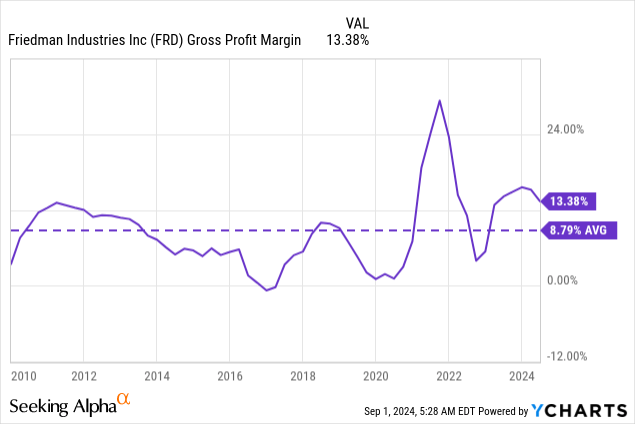Monty Rakusen
Friedman Industries (NYSE:FRD) 1Q25 results were in line with our expectations of flat to lower processing. The operating income damage from lower hot rolled coil prices was offset by hedging.
The quarter confirms our read of prices not affecting long-term profits too much, with more importance given to volumes, which have not grown. However, as of June 2024, Friedman had not hedged its bets, and coil prices have been increasing, which will probably lead to a profitable 2Q25.
Overall, the valuation remains unattractive, considering the company’s long-term production capacity and average profitability. I maintain my Hold rating.
1Q25 in line
Production flat to down: The most important factor for Friedman’s long-term profitability is production volumes. The company has a processing business, where prices up or down in steel coil cancel between quarters or between operating and hedge income.
1Q25 production was disappointing, lower than in the previous quarter, at a total of 133 thousand tons processed. This compares with 143 thousand tons in 1Q24. Since 1Q24, when the company’s Sinton facility started operating and the company added capacity from Mitsubishi, production volumes have remained in the 130 to 140 thousand ton area.
Lower prices hedged: The company posted operating losses for the quarter, as its gross margins contracted from 21% to about 16% this quarter. This was caused by hot-rolled coil prices contracting by 40% from the beginning to the end of the quarter. However, the company recorded $5.4 million in hedging gains, leading to pre-tax profits that, albeit much lower than last year (1/3), were still positive at $3.2 million. This also confirms my view that prices variations do not make such a big deal in Friedman’s profitability.
OpEx increase: Much more concerning was the increment in processing and warehousing expenses (25% YoY), and deliveries (10% YoY). These expenses should not move with coil prices, and therefore constitute a better approximation to Friedman’s true overhead. These costs were offset by lower G&A (-25%). In total, overhead ex-CoGS was up 4.5% or about one million. At post-GFC average gross margins of 9%, this requires an additional $10 million in revenue, or about 10 thousand tons of processing at a price of about $900 per ton. In addition, you have to remember that SG&A has worked as a variable expense in my previous model but is now increasing even with revenues and volumes down.

2Q25 unhedged gains: Looking at the company’s 10-Q for 1Q25, we can observe that it left Q1 without hedged positions. It was short, only 280 tons of hot rolled coil. This means that the company will benefit more from prices moving positively between July and September (its inventories will be sold at a higher price later as finished product). We can observe that HRC futures started July at $650 and are now trading at about $714, with a peak a few weeks ago at $750. This will probably report an accrual gross margin gain.
Valuation remains unattractive
In my previous article, I proposed a model from which I forecasted that Friedman’s long-term operating profits would hover around $20 million per year or $15 million in NOPAT. As of today, the company has an EV of about $150 million or an EV/NOPAT of 10x.
On the market cap side, the company trades at about $105 million. In my model, based on both return on assets minus cost of debt, and operating income minus average interest, I expected the company to produce net income of $10 million. Again, the multiple is around 10x.
I do not believe these multiples are excessive, but they are definitely not opportunistic. Today, there are many companies trading at similar current yields with better prospects for increasing production and less commoditized products.
In my opinion, Friedman is not an opportunity at these prices, but I will continue to watch the stock for potential deeps (especially if an unhedged position causes a higher than expected operational loss).

